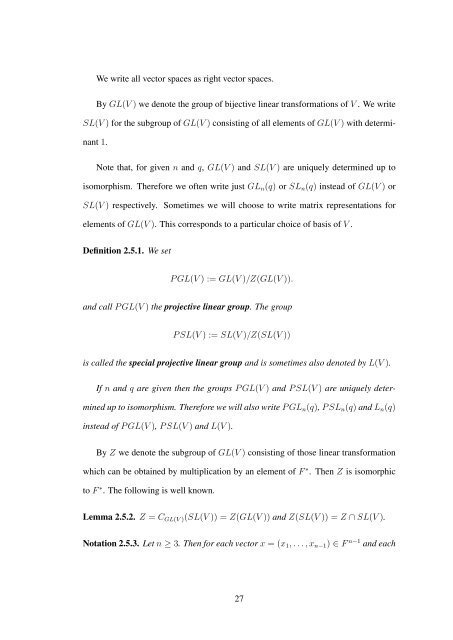SATURATED FUSION SYSTEMS OF ESSENTIAL RANK 1
SATURATED FUSION SYSTEMS OF ESSENTIAL RANK 1
SATURATED FUSION SYSTEMS OF ESSENTIAL RANK 1
Create successful ePaper yourself
Turn your PDF publications into a flip-book with our unique Google optimized e-Paper software.
We write all vector spaces as right vector spaces.<br />
By GL(V ) we denote the group of bijective linear transformations of V . We write<br />
SL(V ) for the subgroup of GL(V ) consisting of all elements of GL(V ) with determi-<br />
nant 1.<br />
Note that, for given n and q, GL(V ) and SL(V ) are uniquely determined up to<br />
isomorphism. Therefore we often write just GLn(q) or SLn(q) instead of GL(V ) or<br />
SL(V ) respectively. Sometimes we will choose to write matrix representations for<br />
elements of GL(V ). This corresponds to a particular choice of basis of V .<br />
Definition 2.5.1. We set<br />
P GL(V ) := GL(V )/Z(GL(V )).<br />
and call P GL(V ) the projective linear group. The group<br />
P SL(V ) := SL(V )/Z(SL(V ))<br />
is called the special projective linear group and is sometimes also denoted by L(V ).<br />
If n and q are given then the groups P GL(V ) and P SL(V ) are uniquely deter-<br />
mined up to isomorphism. Therefore we will also write P GLn(q), P SLn(q) and Ln(q)<br />
instead of P GL(V ), P SL(V ) and L(V ).<br />
By Z we denote the subgroup of GL(V ) consisting of those linear transformation<br />
which can be obtained by multiplication by an element of F ∗ . Then Z is isomorphic<br />
to F ∗ . The following is well known.<br />
Lemma 2.5.2. Z = CGL(V )(SL(V )) = Z(GL(V )) and Z(SL(V )) = Z ∩ SL(V ).<br />
Notation 2.5.3. Let n ≥ 3. Then for each vector x = (x1, . . . , xn−1) ∈ F n−1 and each<br />
27

















